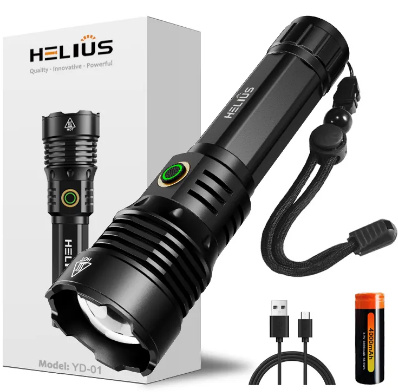What Are the Common Tariffs on Flashlights Imported from China?

When importing from China, flashlights typically face a general tariff rate of 12.5% ad valorem. This rate applies to products classified under HS Code 85131020. However, you may wonder, "What Are the Common Tariffs on Flashlights Imported from China?" In addition to the general tariff, you might encounter extra costs that can significantly impact your total expenses. These include anti-dumping duties, customs fees, and VAT. For example, VAT is calculated by adding the customs value and import duties, then multiplying the total by the VAT rate. Understanding these charges helps you plan better and avoid unexpected costs. By using strategies like proper classification or leveraging free trade zones, you can effectively reduce these expenses.
Key Takeaways
Flashlights from China usually have a 12.5% tariff. This applies to items under HS Code 85131020.
Using the correct HS code is very important. Wrong codes can cause higher fees or fines, so check your product details.
Learn about trade rules and extra costs like anti-dumping fees and VAT. These can raise your total import costs a lot.
Use tools like free trade zones or hire customs brokers. They can lower tariffs and help follow the rules.
Look for special rules or exemptions for your products. These can save you a lot of money on imports.
Understanding Tariff Categories

What Are HS Codes?
How HS codes classify flashlights
HS codes, or Harmonized System codes, play a vital role in international trade. These codes act as unique identifiers for classifying goods, including flashlights. Customs authorities use them to determine the correct tariff rates and ensure compliance with trade regulations. For example, flashlights fall under HS Code 85131020, which specifically covers portable electric lamps powered by dry batteries.
Using the correct HS code ensures that your flashlights are categorized accurately. This classification helps customs officials process your shipment efficiently. It also prevents delays caused by misclassification.
Tip: Always double-check the HS code for your product before shipping. Incorrect codes can lead to higher duties or even rejection of goods.
Why HS codes are critical for determining tariffs
HS codes are essential for calculating the duties and taxes on your imports. They provide a standardized reference for customs and government bodies worldwide. By using the correct HS code, you can avoid unnecessary costs and restrictions.
Here are some key reasons why HS codes matter:
They determine the applicable tariff rates for your product.
They streamline customs clearance by providing accurate product details.
They help you comply with international trade laws.
Accurate HS code usage not only saves money but also ensures a smoother import process.
Common HS Codes for Flashlights
HS Code 85131020 for flashlights
Flashlights imported from China typically fall under HS Code 85131020. This code applies to portable electric lamps designed for handheld use. The general tariff rate for products under this code is 12.5% ad valorem.
However, variations in flashlight materials or features may require a different HS code. For instance, flashlights with specialized functions or unique designs might fall under a different classification.
How to identify the correct HS code for your product
Identifying the correct HS code involves understanding your product's specifications. You should consider factors like material composition, functionality, and intended use. Consulting with a customs broker or using online HS code databases can help you find the right classification.
Note: Misclassification can result in penalties or additional duties. Take the time to verify your HS code to avoid costly mistakes.
By mastering HS codes, you can navigate tariff categories with confidence and reduce import-related challenges.
Current Tariff Rates on Flashlights

General Tariff Rates
The 12.5% duty rate for flashlights
When importing flashlights from China, you face a general tariff rate of 12.5%. This rate applies to products classified under HS Code 85131020. The tariff is calculated as a percentage of the product's customs value. For example, if the declared value of your shipment is $10,000, you will pay $1,250 in duties.
This 12.5% rate is standard for most flashlights. However, it is essential to confirm the classification of your product. Misclassification can lead to incorrect tariff rates, which may result in penalties or delays.
Variations based on flashlight materials or features
Not all flashlights fall under the same tariff rate. Variations in materials or features can affect the classification and, consequently, the tariff. For instance, flashlights with advanced technology, such as rechargeable batteries or waterproof designs, might be classified differently. These differences could lead to higher or lower tariffs.
To avoid surprises, you should review your product's specifications carefully. Consulting with a customs broker can help you determine the correct classification and applicable tariff rate.
Special Tariffs and Trade Policies
Impact of Section 301 tariffs on Chinese imports
Section 301 tariffs are additional duties imposed by the U.S. government on certain goods imported from China. These tariffs aim to address trade imbalances and protect domestic industries. Flashlights are among the products affected by Section 301 tariffs.
Section 301 tariffs increase the overall cost of importing flashlights.
They can make Chinese flashlights less competitive in the U.S. market.
Consumers may face higher prices due to these additional costs.
Understanding how Section 301 tariffs apply to your imports is crucial. You can calculate the total cost of your shipment by adding these tariffs to the general 12.5% rate.
How trade agreements or disputes affect rates
Trade agreements and disputes between the U.S. and China can influence tariff rates. For example, new agreements might reduce tariffs on goods, including flashlights. Conversely, trade disputes could lead to higher tariffs or additional restrictions.
Staying informed about trade policies helps you anticipate changes in costs. Regularly checking updates from the U.S. Customs and Border Protection (CBP) or consulting with a trade expert can keep you prepared.
By understanding these factors, you can better manage the tariffs on flashlights imported from China.
Additional Costs and Regulations
Anti-Dumping Duties
What are anti-dumping duties?
Anti-dumping duties are additional tariffs imposed to protect domestic industries from unfair competition. These duties apply when foreign manufacturers sell products, such as flashlights, at prices lower than their market value. Governments use these measures to prevent market distortion and protect local businesses.
For you, anti-dumping duties can significantly increase import costs. These duties are calculated separately from general customs duties, making it essential to account for them when estimating total expenses.
When and why they apply to flashlights
Anti-dumping duties may apply to flashlights if authorities determine that Chinese manufacturers are selling them below fair market value. This often happens when products are heavily subsidized by the exporting country. If your flashlights fall under this category, you may face higher import taxes.
To avoid surprises, check whether anti-dumping duties apply to your shipment. Consulting with a customs broker can help you navigate these regulations effectively.
Other Import Costs
Customs fees and VAT
When importing flashlights, you must consider customs fees and VAT as part of your total import costs. Here’s a breakdown:
Import duties for LED lights range from 2% to 8%, with some being duty-free.
VAT is calculated by adding the customs value and import duties, then multiplying by the VAT rate. For example, if the total after duties is $6,160 and the VAT rate is 20%, you would pay $1,232 in taxes.
Understanding these calculations helps you plan your budget more accurately.
Documentation and compliance costs
Proper documentation is critical for smooth customs clearance. You need to prepare invoices, packing lists, bills of lading, and HS codes. Some shipments may also require certificates of origin or import licenses.
Non-compliance with regulations can lead to penalties or shipment delays. Automating compliance processes can reduce operational burdens and improve efficiency. Regular audits and proper labeling also ensure adherence to local standards.
Trade Restrictions and Agreements
U.S.-China trade relations and their impact
Trade relations between the U.S. and China directly affect the cost of importing flashlights. During the trade war, U.S. tariffs impacted 74.7% of Chinese exports to the U.S. These tariffs increased costs for manufacturers and consumers, leading to higher flashlight prices.
Staying informed about trade policies helps you anticipate changes in tariffs and import taxes. Compliance with customs regulations also minimizes delays and fines.
Exemptions or special provisions for certain products
Some flashlights may qualify for exemptions or reduced tariffs under specific conditions:
Free Trade Agreements (FTAs) may reduce or eliminate tariffs on certain goods.
Duty-free zones allow goods to be exempt from duties if stored or processed there.
Temporary imports for exhibitions or projects may qualify for duty-free status if re-exported.
Industry-specific reductions may apply to products that meet environmental standards.
Exploring these options can help you lower your overall import costs.
Tips to Minimize Tariffs
Proper Classification of Goods
Ensuring accurate HS code assignment
Accurate HS code assignment is essential for managing tariffs effectively. You must ensure that your flashlights are classified under the correct HS code, such as 85131020, to avoid unnecessary costs. Misclassification can lead to higher tariff rates or penalties. Reviewing your product's specifications, such as materials and features, helps you determine the right classification.
Tip: Use online HS code databases or consult a customs broker to verify your product's classification. This step minimizes errors and ensures compliance with customs regulations.
Avoiding misclassification penalties
Misclassification not only increases costs but also delays shipments. Customs authorities may impose fines if they find discrepancies in your documentation. To avoid this, double-check your HS code and ensure all paperwork aligns with your product's details.
Note: Investing time in proper classification saves you from costly penalties and ensures a smoother import process.
Leveraging Free Trade Zones
Benefits of using bonded warehouses
Bonded warehouses offer several advantages for flashlight imports:
Deferred payment of import duties improves cash flow.
Enhanced safety and security protect your goods.
Proximity to transportation hubs reduces lead times and costs.
Avoidance of double fees facilitates manufacturing for export.
Extended storage of restricted goods allows time for documentation.
These benefits make bonded warehouses a valuable tool for reducing tariff-related expenses.
How free trade zones reduce costs
Free trade zones (FTZs) help you save on tariffs by leveraging trade agreements. If your flashlight supplier operates in a country with a Free Trade Agreement (FTA) with your destination, you can benefit from reduced or zero tariffs. Confirming this with your supplier or customs broker can lead to significant savings.
FTAs directly lower the overall costs of importing flashlights, improving your profitability. By utilizing FTZs, you can also defer duties until goods leave the zone, further optimizing your cash flow.
Consulting with Customs Brokers
Role of customs brokers in tariff management
Customs brokers play a crucial role in managing tariffs for flashlight imports. They ensure compliance with customs regulations, assist in accurate classification, and identify cost-saving opportunities like duty drawbacks or exemptions. Their expertise helps you navigate complex tariff structures and avoid costly errors.
How to choose the right broker for your needs
Selecting the right customs broker is vital for a smooth import process. Look for brokers with expertise in trade compliance and a strong understanding of tariffs and regulations. Experienced brokers handle documentation efficiently, reducing the risk of errors. They also identify opportunities to save on tariffs, enhancing your profit margins.
Tip: Partnering with a knowledgeable customs broker allows you to focus on other aspects of your business while ensuring your imports comply with all regulations.
Flashlights imported from China face a 12.5% general tariff rate, but additional costs like anti-dumping duties and customs fees can increase your expenses. Accurate HS code classification ensures you avoid misclassification penalties and manage tariffs effectively. You should also stay informed about trade policies to anticipate changes in costs.
To reduce expenses, explore strategies like leveraging free trade zones or checking if your flashlights qualify for tax exemptions. Negotiating with suppliers for bulk discounts and sourcing from countries with Free Trade Agreements can also help. Working with a customs broker ensures compliance with customs regulations and avoids unexpected charges.
By implementing these strategies, you can streamline the process of importing from China and minimize costs. This approach allows you to focus on growing your business while managing tariffs efficiently.
FAQ
1. What is the HS Code for flashlights imported from China?
The HS Code for most flashlights is 85131020. This code applies to portable electric lamps powered by dry batteries. Always verify your product's specifications to ensure accurate classification.
2. How do I calculate the total tariff for my flashlight imports?
Add the 12.5% general tariff rate to any applicable Section 301 tariffs or anti-dumping duties. Multiply the total by the customs value of your shipment. For example:
Customs Value: $10,000
Tariff: $1,250 (12.5% of $10,000)
3. Are there exemptions for tariffs on flashlights?
Yes, some exemptions exist. Products stored in free trade zones or qualifying under Free Trade Agreements (FTAs) may receive reduced or zero tariffs. Check with your customs broker for eligibility.
4. What happens if I misclassify my flashlights?
Misclassification can lead to penalties, shipment delays, or higher tariffs. Customs authorities may reject your goods if the documentation does not match the product. Always double-check your HS code to avoid these issues.
5. Can I reduce costs by using bonded warehouses?
Yes, bonded warehouses allow you to defer import duties until your goods leave the warehouse. This improves cash flow and reduces immediate expenses. They also provide secure storage and help avoid double fees for re-exported goods.
See Also
A Comprehensive Look at LED Flashlight Quality Standards
Key Strategies for Sourcing Flashlights from Chinese Suppliers
Tips for Importing Quality Flashlights at Wholesale Rates
Boost Your Profits by Sourcing Flashlights Wholesale
Expert Tips for Negotiating Home Flashlight Wholesale Prices
